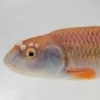If you spot me doing anything wrong that would prevent the fish from living happily or from breeding, please tell me.
I received an adult male, two (or three?) females, and several fry/juveniles and some live food from a very nice NANFA member this week. They were housed initially in a 10 gallon aquarium with a standard hood (3 inch incadensent bulbs), a layer of half inch gravel substrate, and hornwort (ceratophyllum). There is an airstone amidst the mass of ceratophyllum. The ceratophyllum is made to sink beneath the surface (it would naturally float to the top) by being wrapped around a rectangular 1/2 inch PVC tube frame, the bottom half of which is buried in the gravel.
But then I read on another NANFA forum that the Elassoma fry have a higher survival rate with sand substrate than they do in gravel. Apparently the fry are so small that they can get stuck in the small interstitial points of a gravel substrate. So I went to Home Depot and picked up a bag of Pavestone Play Sand ($4), removed all of the gravel from the aqurarium, and slowly added cups of sand. This caused me intense stress (omg there are fish in this tank! What if I squish one! *moves really slowly*) but the fish didn't seem to mind. One of the fish was actually far less shy when the water was murky from sand, and tolerated me staring at it. Now that the water has cleared, they're all back to hiding in the plants all the time. They are very very shy. If I walk near the tank, they all hide.
When I was at Home Depot I also picked up two 18 inch lights, $10 each, to make the aquarium brighter. They're kind of yellow, though, which I'm not too pleased about, but at least they're better than the hood that came with the aquarium. Oh, they didn't quite fit in the tank (20 inch opening) so I used packing tape to decrease the aquarium lip a little. The lights are resting on the taut packing tape a few inches above the surface of the water. It is very stable.
Here is a picture of the aquarium, taken just now, which is two or three days after the sand was added:
 E. gilberti tank after sand settled.jpg 212.19KB
31 downloads
E. gilberti tank after sand settled.jpg 212.19KB
31 downloadsI am adding crushed flake food every five hours or so (a tiny tiny bit. The snails can handle it even if the E. gilberti eat none of it). And I add microworms once a day. And there are moina and rotifers. I've also purchased a colony of special, extremely small moina on aquabid that should be arriving in the mail and housed in a 2 L former soda pop container.
By the way, microworms are becoming my favorite thing ever. You just let them sit in their little container, and they breed, and you feed them to your fish. It's so easy. And they're kind of cute, too, the way they wiggle.
Yup, that's the progress so far. I have to say, I really am not happy with how shy the Elassoma gilberti are. Hopefully they'll get used to seeing the big giant head in the window like the darters in my 55 gallon aquarium did (they were shy when I first got them, but eventually got over it). Because the majority of the time when I try to find fish in that tank, I can't. I'm actually more likely to see one of the two extremely tiny cherry shrimp. *sighs*
I do, however, like how they color change. When they first arrived and were being lifted out of their box, the fish were very very pale, basically clear. When I was temperature and pH adjusting them in their floating bags surrounded by dense plants, they changed to sandy brown. And the one fearless one I saw when the sand was still making the water murky was a light brown with dark brown stripes on it. I hope that in time they will become less shy and even more colorful.
Edited by Okiimiru, 22 August 2010 - 01:33 PM.


 This topic is locked
This topic is locked




